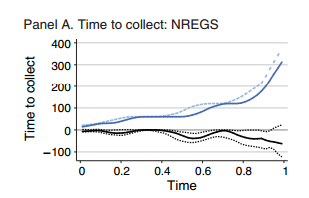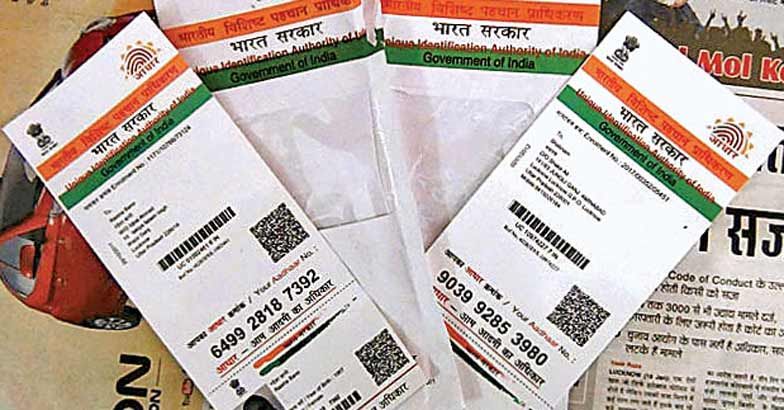On the 27th of March 2017, responding to the increased uproar in the compulsory use of the Aadhaar Card for non-welfare related schemes, the Supreme Court of India announced the decision in favor of the Indian Government, granting them the power to make the Aadhaar Card mandatory for most schemes. Although, for most welfare related scheme the Government is prohibited by law to demand an Aadhaar card, this decree has enabled the Modi Administration to pursue their agenda on creating a single identification document as well as promoting ‘Digital India’. The primary focus, in an article written by Kanishka Singh, http://indianexpress.com/article/what-is/what-is-aadhaar-card-and-where-is-it-mandatory-4587547/, revolves around the different schemes where an Aadhaar Card would be compulsory and is the main talking point in the Indian Government’s plan of targeting and eradicating poverty (World Bank 2013).
With the exponential rise in the population in India, the Government has been facing a tough time in order to implement a system so as to capture and unify the citizens in a single database. ‘Digital India’ allows the government to implement and promote technology in order to benefit the society. The Unique Identification Authority of India (UIDAI) created the Aadhaar, issuing every individual with their own unique 12-digit identification number, storing each individual’s biometric as well as demographic data.
Reviewing an article by the World Bank, we observe that inspite of spending close to 2% of its GDP on social welfare programs, the Indian Government has not been fully efficient in distributing resources to the needy and poor in the country (“India’s aid schemes fail to tackle poverty: World Bank” 2011). Due to the high level of corruption existing within the government as well as the existence of multi-level distribution systems of welfare, and the inefficiencies involved with them, funds that are allocated by the central government gets lost before it reaches the household of the targeted recipients. The Aadhaar Initiative seeks to disrupt this system and aims to directly target individuals and households thereby reducing poverty through carefully constructed welfare transfer schemes, as noted by World Bank President Jim Yong Kim (PTI 2017).
The Poverty Index Framework
The Headcount Ratio describes the percentage of the population that is below the global official poverty line, additionally, the Poverty Gap Index, or the P1 Index, measures the average amount of funds that must be distributed to the poor so as to alleviate them from poverty. The primary way for the government to engage in redistribution of resources has been through ration cards as well as through various multi-level channels, following a hierarchal path from the center to the state and then further divided up into districts before finally reaching the recipient. Targeting a poor population of close to 224 million people is a herculean task (Business Today 2016). The inefficiencies of the Public Distribution System are highlighted in the literature by Vivek Kaul, which found that 48% of sugar and 15% of rice allocated for the poor, had been lost in the process of the transfer (Kaul 2016). Rice and Sugar are just a few commodities, the problem is faced in a slew of different commodities which are required by the poor in India and are subsidized, yet fail to reach the recipient causing a massive dent in the progress of social welfare programs. The Aadhaar Initiative provides us with a framework where the middle man is eliminated and the government is able to directly target the poor section, thereby taking a stride forward in reducing poverty via a direct transfer of cash that is not leaked midway.
In order to understand how the Aadhaar Smart Cards would help to target the poor section of the society, directly benefitting the poor and thereby reducing poverty, we need to assume the assumptions held by the Aadhaar Initiative to explain the model. Currently, in order for a poor person to benefit from the subsidy given by the Indian Government, he or she needs to use their ration card and go to the nearest government store where they are allocated their fair share of commodities based on the limited supply they obtain. Let us observe the sequence of events as seen in Panel A. After a worker has filed a report claiming their need of funds or subsidized commodities, indicating that they are poor, the Gram Panchayat collects all the data and sends it to the Mandal, a computer center which consolidates the data and sends it to the state government for review. Using the funds the center has allocated to the state, the state then seems to divide up commodities as well as cash transfer based on smaller districts, which is then distributed to the local level or the Gram Panchayat before finally reaching the recipient.
The numerous levels associated with Panel A leads to the inefficient targeting and thus does not benefit the poor. Looking at how Aadhaar cards would help, we see the existence of fewer channels of distribution. Once the state has all the information and the exact number of poor people, they transfer equivalent cash amounts to the bank, which in turn works with the Technology and Customer Service Provider to identify the workers and transfer the money directly to their bank accounts.

* Picture Taken from Karthik Muralidharan’s “Building State Capacity: Evidence from Biometric Smartcards in India”


* Picture Taken from Karthik Muralidharan’s “Building State Capacity: Evidence from Biometric Smartcards in India”
Blue dotted line is the control group- No access to Smart Card
Blue solid line is the treatment group- Access to Smart Card
Going a step forward, provided the model is functional, we should notice an improvement in the efficiency in the Public Distribution System. Our model seems to match with Muralidharan’s experiment. Looking at Panel A and Panel B, we notice that the using smartcards would enable the government to be able to target the poor section and efficiently transfer funds to their accounts without further delay.
For the model to function, we assume that there would be a substantial investment in technology in rural India, since it is observed that these regions are marked by low levels of technology (Punj 2012). Given the fact that most people in rural India not having bank accounts, we further to go ahead and assume that there exists procedures where the government can incentivize the public to open bank accounts, further assume that both private and public banks would like to extend their branches to all parts of the company. As the article mentions, by making programs compulsory, the government is able to spread awareness and encourage citizens to obtain their Aadhar cards. There is a huge market for private data collection companies to benefit from this scheme. Owing to the large population, data collection firms would partner with the Government in order to obtain the biometric data. Another industry which would thrive would be the cyber security sector, which would have to be set up to monitor the vasts amount of data that is collected and stored through this plan. The government has a long way to go and must take on the task of education its citizens to adopt 21st century technology so that it can show to the world that poverty too can be tackled digitally.
Works Cited
“India’s Massive I.D. Program Exemplifies ‘Science of Delivery'” World Bank. N.p., 2 May 2013. Web. 01 Apr. 2017. <http://www.worldbank.org/en/news/feature/2013/05/02/India-8217-s-Massive-I-D-Program-Exemplifies-8216-Science-of-Delivery-8217>.
“India’s aid schemes fail to tackle poverty: World Bank.” OWSA. N.p., 19 May 2011. Web. 02 Apr. 2017. <http://southasia.oneworld.net/news/indias-aid-schemes-fail-to-tackle-poverty-world-bank#.WOETNzvyvIU>.
Kaul, Vivek. “There Is A Very Compelling Case For India To Move To Cash Transfer Of Subsidies.” Huffington Post India. The Huffington Post, 26 Feb. 2016. Web. 02 Apr. 2017. <http://www.huffingtonpost.in/2016/02/26/economic-survey-india-201_n_9325372.html>.
McGivering, Jill. “India aid programme ‘beset by corruption’ – World Bank.” BBC News. BBC, 18 May 2011. Web. 02 Apr. 2017. <http://www.bbc.com/news/world-south-asia-13447867>.
Muralidharan, Karthik, Paul Niehaus and Sandip Sukhtankar. 2016. “Building State Capacity: Evidence from Biometric Smartcards in India.” American Economic Review, 106(10): 2895-2929.
PTI. “Aadhaar to help eradicate poverty, says World Bank chief Jim Yong Kim.” The Economic Times. Economic Times, 09 May 2013. Web. 02 Apr. 2017. <http://economictimes.indiatimes.com/news/politics-and-nation/aadhaar-to-help-eradicate-poverty-says-world-bank-chief-jim-yong-kim/articleshow/19964577.cms>.
PTI. “India has highest number of people living below poverty line: World Bank.” Business News – Latest Stock Market and Economy News India. Living Media India Limited, 3 Oct. 2016. Web. 02 Apr. 2017. <http://www.businesstoday.in/current/economy-politics/india-has-highest-number-of-people-living-below-poverty-line-world-bank/story/238085.html>.
Punj, Shweta. “Aadhaar: How the UID Project Can Transform India.” Aadhaar: How the UID Project Can Transform India. Living Media India Limited, 04 Mar. 2012. Web. 2 Apr. 2017.
Singh, Kanishka. “What is Aadhaar card and where is it mandatory?” The Indian Express. N.p., 27 Mar. 2017. Web. 01 Apr. 2017. <http://indianexpress.com/article/what-is/what-is-aadhaar-card-and-where-is-it-mandatory-4587547/>.
Top picture by: http://english.manoramaonline.com/news/nation/aadhaar-card-must-lpg-subsidy-time-november-30.html

It’s fascinating to see the “generation skipping technology” being deployed in India and other developing countries. These smart cards have so many uses — they can be used to reduce costs of benefit programs, as you describe, to enforce the incentive to repay loans from private lenders, and even as a nudge towards financial inclusion to increase savings and investment.
LikeLike
The US spends nearly twice that India does in terms of a percentage of its GDP, and distribution certainly isn’t as effective as it could be here either. The smartcards look like a great way for India to jump-start improvement on welfare distribution. Also, seeing how they will be receiving their social welfare in commodities instead of cash, you can be sure that the social welfare will be going towards the correct uses.
LikeLike
Digital India seems to be a fascinating way to get around the frequent issues of corruption and imperfect targeting that developing countries face. However, the issue of proper spending could arise if the transfer becomes primarily cash-based and funneled through banks.
An additional benefit of this development strategy may be the spread of banking to more of the population, spurring savings and maybe even further development in poverty-stricken areas. This type of technology-assisted development may prove to be a game changer in development economics: in addition to micro-targeted welfare, these kinds of government programs could spur further innovation in technology and banking which could be replicated in other countries as well.
LikeLike